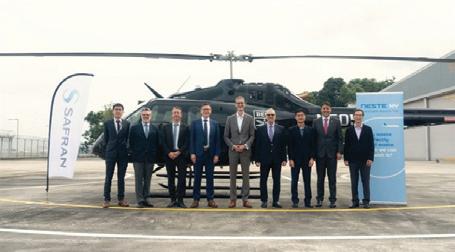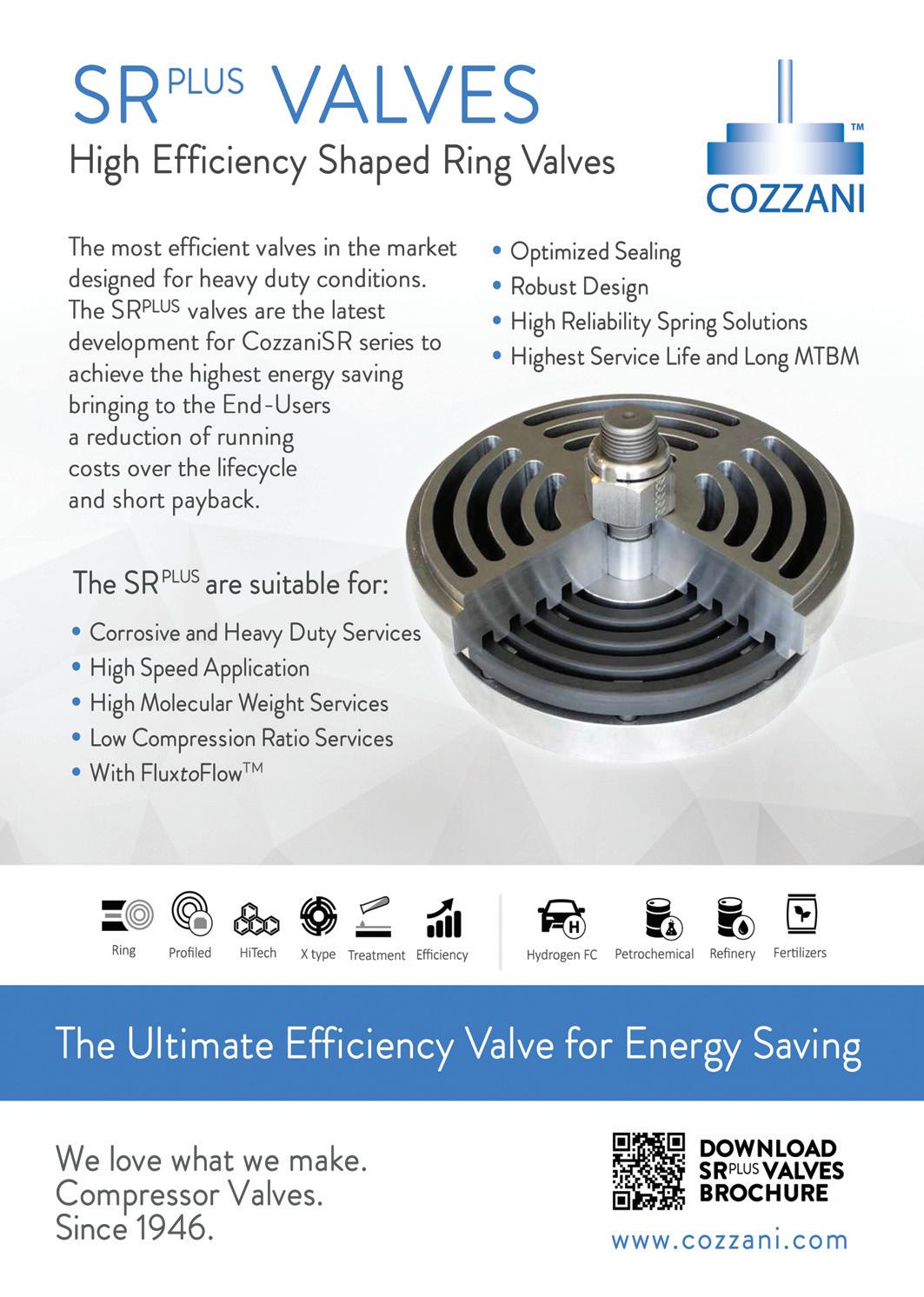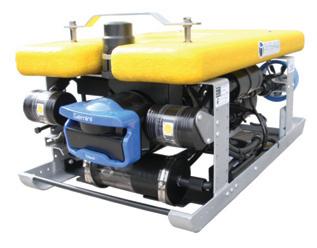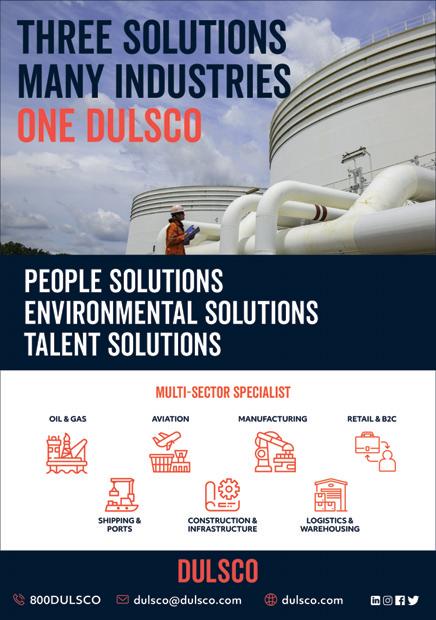
13 minute read
Oil and gas news in brief
from OG34
Keeping you up to date with market leaders
latest
news
Amarinth wins $500K order for API 610 OH2 pumps destined for the Karachaganak Field, Kazakhstan
Amarinth, a world-leading, net-zero designer and manufacturer of low lifecycle cost centrifugal pumps and associated equipment, has won a $500,000 order from KPO in Kazakhstan for six API 610 OH2 pumps. Amarinth makes pumps for nuclear and renewable energy generation, defence, desalination, process and industrial markets.
The Karachaganak field is the biggest gas condensate field in Kazakhstan and is owned and operated by Karachaganak Petroleum Operating (KPO). The onshore field is near Aksai, in northwest Kazakhstan and covers an area of over 280 square kilometres. KPO approached Industrial Systems Group (ISG), an Amarinth agent and leading supplier of high-quality equipment for the oil & gas and associated industries in the Caspian region.
This order followed previous purchases placed though ISG that were successfully fulfilled by Amarinth. The six API 610 OH2 pumps will be used for water and caustic fluid transfer duties. The company’s process pumps are horizontal, vertical and in-line bespoke process pumps, hydraulically and dimensionally interchangeable with the former Girdlestone and other obsolete pumps.
The pumps will be winterised to work reliably when operating in temperatures ranging from -40°C to 65C and will be manufactured in Low Temperature Carbon Steel. They are also designed to connect directly to existing KPO Variable Speed Drives.
The pumps will be EAC Certified, proving the equipment complies with the Eurasian Economic Union (EEU) regulations and standards for customs clearance and trade. Amarinth is also handling the complex GOST-K Certificate of Conformity documentary evidence required by Kazakhstan law. This is to prove that the equipment meets Kazakhstan’s requirements and standards, something that, once again, the company has developed expertise in.
Oliver Brigginshaw, Managing Director of Amarinth, commented: “We are delighted to receive another order from KPO through ISG, our agent in the region. The confidence from KPO in Amarinth to deliver reliable pumps working in such arduous conditions underlines our on-going commitment, alongside our agent ISG, to the oil and gas industry in the Caspian region.”
Amarinth is a world-leading company specialising in the design, application and manufacture of centrifugal pumps and associated equipment to the offshore and onshore oil and gas exploration, production and refining industry, petrochemical, chemical, industrial and power markets.
Discovered in 1979, Karachaganak is one of the world’s largest gas and condensate fields. It holds an estimated hydrocarbons initially in place (HIIP) of 9 billion barrels of condensate and 48 trillion cubic feet (tcf) of gas, with estimated gross reserves of over 2.4 billion barrels of condensate and 16 tcf of gas.
In 1997, Venture partners, including Shell, Chevron and KazMunaiGas set out with the former State Oil & Gas Authority to develop the vast reserves of Karachaganak. They signed a Final Production Sharing Agreement (FPSA) which will see the partnership operate Karachaganak until 2038. Since signing this agreement, they have invested over $28.3 billion in the operations and have applied industry leading hydrocarbon technology to one of the world’s most complex reservoirs.
In 2021, hydrocarbon production in Karachaganak reached 134.05 million barrels of oil equivalent. 10 billion cubic metres of gas, which is approximately 52.7% of the total gas produced, was re-injected to maintain reservoir pressure.
iOG& inside(( OIL&GAS SEND US YOUR NEWS
Our team would love to help tell your company’s story, sharing your latest news to a wide range of readers and contacts around the world.
Send your news to: media@insideoilandgas.com

Southeast Asia’s first helicopter flight using sustainable aviation fuel takes off in Singapore

Bell’s next generation five-seater helicopter, the Bell 505, fuelled with Neste MY Sustainable Aviation Fuel (SAF) has taken off at Seletar Airport in Singapore for a demonstration flight. This is the first ever helicopter flight fuelled with SAF in Southeast Asia.
This remarkable milestone was achieved by a close cooperation between Bell, Safran Helicopter Engines and Neste, with Jet Aviation and Shell Aviation enabling the blended SAF to be uplifted through their facilities at Seletar Airport. The demo flight showcases the commitment of the business aviation community to the industry’s ambitious emissions reduction goals and adopting SAF as a key element in helping achieve these goals.
Neste MY Sustainable Aviation Fuel reduces greenhouse gas emissions by up to 80% over the fuel’s life cycle compared to fossil jet fuel use. SAF can currently be used up to 50% blended with conventional jet fuel, and Safran helicopter engines are already certified to operate on up to 50% SAF.
“Bell has been in Southeast Asia for more than 40 years and we are proud to operate the first SAF helicopter flight here on our Bell 505,” said Jacinto Monge, managing director, Asia Pacific, Bell. “Today’s flight demonstrates our commitment to incorporating SAF into our customer demonstration aircraft globally, supporting Textron’s Achieve 2025 Sustainable Footprint goal for 20% reduction in greenhouse gas emissions.”
“We strongly believe in SAF, as it contributes to significantly reducing CO2 emissions,” said Valerie Patuel, Managing Director of Safran Helicopter Engines Asia, CEO & Country General Delegate of Safran Singapore. “As with all our helicopter engines, the Arrius 2R, is already certified to operate on up to 50% SAF, and we are fully ready to assist all Bell 505 operators worldwide in their transition from conventional fossil fuels to SAF. With our products, we are proud to play an active role in the development of decarbonisation initiatives in Asia Pacific.”
“The ambitious emissions reduction goals of the aviation industry can only be achieved through wide-scale adoption and use of sustainable aviation fuel,” said Sami Jauhiainen, Vice President APAC, Renewable Aviation at Neste, “and cooperation across the stake-
holders in the aviation ecosystem. With today’s demo flight, we showcase that SAF can safely and easily be used also for helicopter operations. I am also proud that this milestone was achieved in Singapore. With the expansion of our Singapore refinery nearing completion, and the ongoing modification of our Rotterdam refinery, we will be able to produce up to 1.5 million tons of SAF by the end of 2023, ready to support aviation globally and in the Asia-Pacific region.”
SAF delivers the performance of conventional jet fuel but with a significantly smaller carbon footprint on a life cycle basis. Neste MY SAF is produced 100% from sustainably sourced, renewable waste and residue raw materials, such as used cooking oil and animal fat waste. Neste MY Sustainable Aviation Fuel is a today solution, commercially available and in use worldwide.

Keeping you up to date with market leaders
latest

news
bp to sell its business in Algeria to Eni
bphas announced that it has agreed to sell its upstream business in Algeria to Eni, the Italian energy company. This includes its interests in the gas-producing In Amenas and In Salah concessions. bp holds working interests of 33.15% and 45.89% in the In Salah and In Amenas projects respectively. Both are operated by joint ventures co-owned by bp, Equinor and Sonatrach.
Anja-Isabel Dotzenrath, bp’s executive vice president in gas & low carbon energy, said: “bp has worked successfully with Algeria and our partners over almost 30 years, developing and supporting operations on two major gas projects for the country. We believe this agreement represents a good outcome for bp and Eni and for Algeria.”
Karim Alaa, bp’s senior vice president for Egypt, Algeria and Libya, added: “We are very proud of what bp has achieved in Algeria over many years and have appreciated the support of the government over this time. With its significant existing presence in Algeria and wider region, we believe Eni will be well positioned to work with partners and the government as they continue to take these assets forward.”
The In Salah Gas joint venture has developed seven gas fields in the Southern Sahara, approximately 1,200 kilometres south of Algiers. Production began in 2004 with a second phase starting up in 2016. The In Amenas joint venture produces gas and natural gas liquids from the Illizi basin in south-eastern Algeria, with first production coming in 2006.
The companies have informed partners and the relevant Algerian government entities of their agreement. The transaction is subject to government approvals, partner pre-emption processes, and competition clearance processes. bp has been a major investor in Algeria for almost 30 years and has helped deliver two major gas developments at In Salah Gas and In Amenas, accounting for up to 15% of Algerian gas exports. Both are non-operated joint ventures, managed in partnership with Equinor and Sonatrach, the national oil company of Algeria.
The In Amenas joint venture is one of the largest wet gas projects in Algeria and involved the development and production of natural gas and gas liquids from fields in the Illizi Basin in south-eastern Algeria. First gas was produced at In Amenas in 2006.
The In Salah gas joint venture is one of the largest dry gas jointventure projects in the country and involves the development of seven proven gas fields in the southern Sahara, 745 miles (1,200km) south of Algiers. The first phase of development came on stream in July 2004 with the second phase, the In Salah Southern Fields project, coming online in February 2016 and developing the remaining four fields.


Keeping you up to date with market leaders
latest

news
White River Energy and Ault Energy successfully complete drilling project in Mississippi
White River Energy Corp has announced that Ault Energy, a wholly owned subsidiary of BitNile, and White River Operating LLC, a wholly owned subsidiary of White River, have successfully completed drilling a 9,531 foot well, ‘the Harry O’Neal 20-9 No. 1’ on White River’s oil and gas mineral lease in Holmes County, Mississippi. The O’Neal No. 1 Well was logged by an independent Fortune 500 oilfield services company and had productive oil results across multiple pay-zones in the Smackover formation. The partnership plans to jointly drill approximately 100 oil wells over the next five years.
WR Ops has commenced the completion process on the O’Neal No. 1 Well and anticipates pumping the O’Neal No. 1 Well in mid-October 2022 as an economically viable oil well.
“The recent success of our development drilling strategy at Horseshoe Lake in Holmes County, MS via our vertically integrated business model is an exciting first step in our relationship with Ault Energy,” stated Randy May, Executive Chairman of White River.
BitNile Founder and Executive Chairman Milton “Todd” Ault, III, who also serves as the Manager of Ault Energy, said, “We are pleased to announce the successful drilling of an economically viable producing oil well. My team and I conducted a site visit to the in-progress drilling project in September 2022, and we were very impressed with White River’s drilling operations, management, and geological capabilities. We look forward to participating in additional drilling projects with White River over the next several months.”
White River’s next drilling project is expected to be a 14,000 ft deep vertical oil well in the Wilcox, Austin Chalk, and Tuscaloosa Marine Shale formations in the Coochie Oil Field in Concordia Parish, LA. White River also plans to drill three consecutive deep vertical drilling projects at approximately 13,000 ft in the Rodessa and Hosston sand formations on the Pisgah Field Lease in Rankin County, MS.
A new platform in Brazil, Peregrino C, is set to produce its very first oil
Peregrino phase 2 will extend the Peregrino field life to 2040. Phase 2 adds 250-300 million barrels of oil, while at the same time halving expected CO2 emissions per barrel over the field remaining lifetime.
“I am thrilled that we have started production from the new Peregrino C platform. Covid-19 has made Peregrino phase 2 a challenging project, and I want to thank everyone involved for delivering the project with excellent HSE results,” said Geir Tungesvik, Equinor’s executive vice president for Projects, Drilling & Procurement.
Peregrino phase 2 consists of a new platform with drilling facilities and living quarters tied in to the existing Peregrino FPSO, as well as a new pipeline importing gas to the platform for power generation. The new platform will provide 350 long-term jobs offshore and onshore in Brazil.
The project was on schedule for planned start-up late in 2020 when Covid-19 hit the project hard, leading to cuts in the workforce several times in the crucial and normally labour-intensive hook-up phase. Still, Peregrino phase 2 is delivered within the original $3 billion cost estimate.
In line with Equinor’s low carbon strategy, measures have been taken to reduce CO2 emissions from the Peregrino field. By switching from diesel to gas for power generation on Peregrino C, phase 2 will avoid 100,000 tonnes of CO2 emissions from the Peregrino field per year.
C-Innovation and Grand Isle Shipyard awarded plug and abandonment contract for major deep-water client

C-Innovation (C-I) and Grand Isle Shipyard, LLC (GIS), two strategic oil and gas industry partners, have been awarded a plug and abandonment contract by Helix Alliance Decom, LLC to provide pre-feed services for the decommissioning of three offshore platforms for a major deep-water client.
In Phase I of the project, C-I provided ROV services to deliver marine water inspection and integrated the data within MODS software to provide live operations for the client operating fixed leg platforms in 165 – 200 feet of water. The GIS Aerobotics Drone Division provided aerial inspection services. The joint technical innovations aim to determine the current condition of the wells and the facility, enabling the timely and cost-effective decommissioning of the wells, platform and jacket for each of the three platforms.
The partnership harnessed its technology to offer increased safety margins. All of the inspections were able to be completed via line wireless transmission from the back of the boat within a connex box without requiring the deployment of personnel on ropes.
Michael MacMillan, operations manager, C-I, stated: “The equipment used took very little time to mobilise and provided subsea operations in a safe and efficient manner while using a limited number of personnel. The ability to launch this type of ROV from almost any asset not only allows operations to be efficient but also mitigates safety risks while practically eliminating the traditional risks associated with the launch and recovery of an ROV.”
DaCoda Bartels, GIS aerobotics division manager and pilot, said: “The GIS drone can safely operate from up to 100 ft away from the asset as we have the camera stabilisation technology to zoom in on an area of interest. Most of these areas are not accessible by human personnel. We are able to live stream the drone’s camera view in real time to make informed decisions on the spot. It’s a super-fast and super safe alternative, where the only potential risk is to the equipment rather than the personnel.”
MacMillan added, “Our partnership with GIS enables C-I to continue to demonstrate our flexibility to provide resources and equipment in a non-traditional scenario. The availability of equipment and personnel for these types of scopes is more important now than ever, due to the demands of today’s market.”












